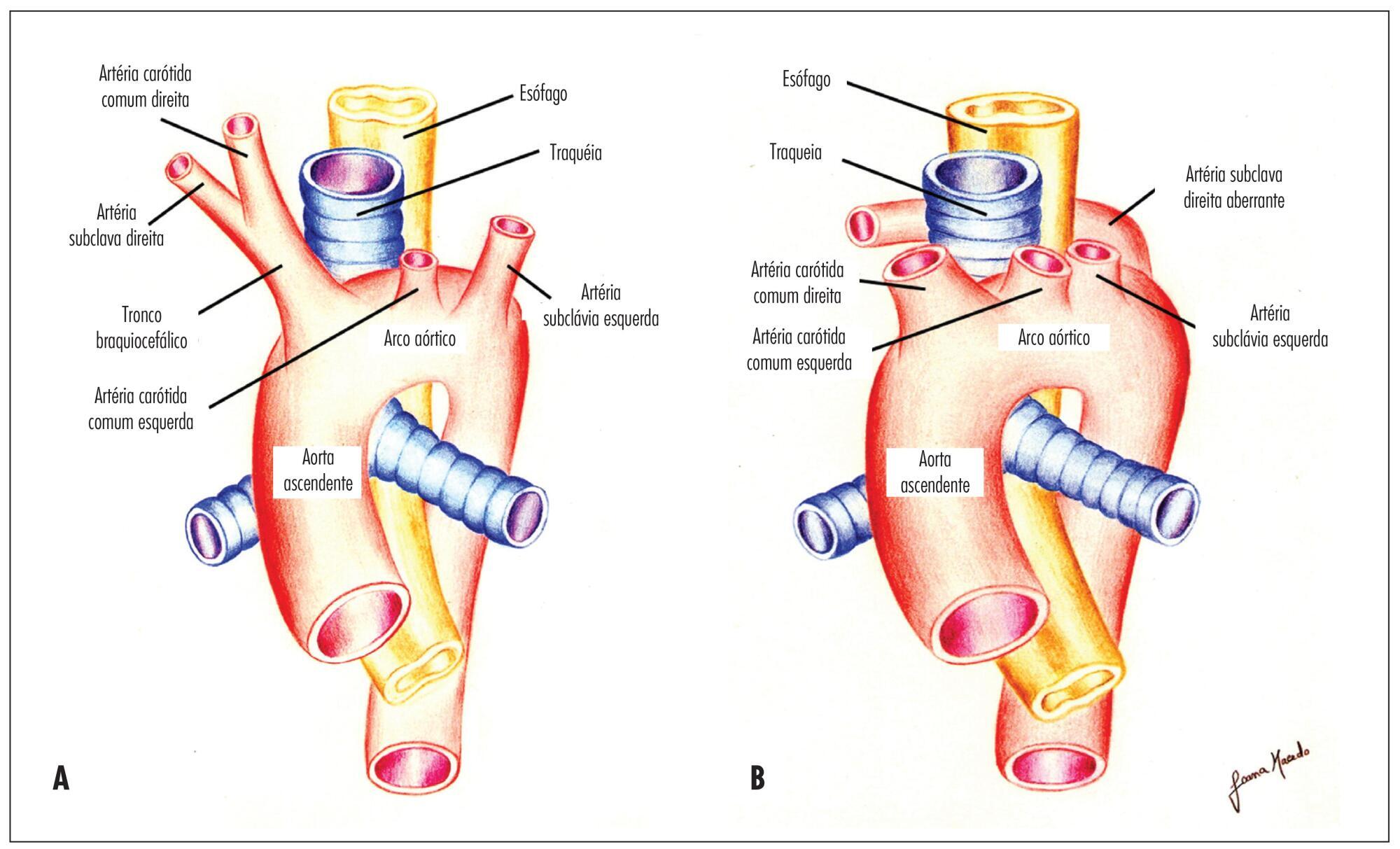Summary
Revista Brasileira de Ginecologia e Obstetrícia. 2021;43(4):250-255
To investigate the effect of closure types of the anterior abdominal wall layers in cesarean section (CS) surgery on early postoperative findings.
The present study was designed as a prospective cross-sectional study and was conducted at a university hospital between October 2018 and February 2019. A total of 180 patients who underwent CS for various reasons were enrolled in the study. Each patient was randomly assigned to one of three groups: Both parietal peritoneum and rectus abdominis muscle left open (group 1), parietal peritoneum closure only (group 2), and closure of the parietal peritoneum and reapproximation of rectus muscle (group 3). All patients were compared in terms of postoperative pain scores (while lying down and duringmobilization), analgesia requirement, and return of bowel motility.
The postoperative pain scores were similar at the 2nd, 6th, 12th, and 18th hours while lying down. During mobilization, the postoperative pain scores at 6 and 12 hours were significantly higher in group 2 than in group 3. Diclofenac use was significantly higher in patients in group 1 than in those in group 2. Meperidine requirements were similar among the groups. There was no difference between the groups’ first flatus and stool passage times.
In the group with only parietal peritoneum closure, the pain scores at the 6th and 12th hours were higher. Rectus abdominismuscle reapproximations were found not to increase the pain score. The closure of the anterior abdominal wall had no effect on the return of bowel motility.
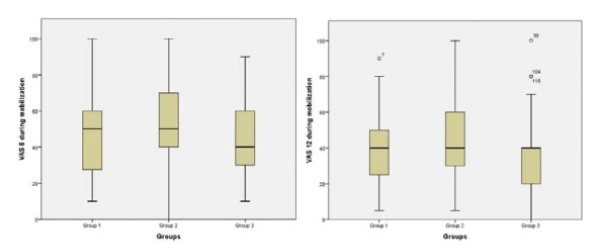
Summary
Revista Brasileira de Ginecologia e Obstetrícia. 2004;26(3):251-251
Summary
Revista Brasileira de Ginecologia e Obstetrícia. 2014;36(6):251-258
DOI 10.1590/S0100-720320140004976
To assess the effects of a soy dietary supplement on the main biomarkers of cardiovascular health in postmenopausal women compared with the effects of low-dose hormone therapy (HT) and placebo.
Double-blind, randomized and controlled intention-to-treat trial. Sixty healthy postmenopausal women, aged 40-60 years, 4.1 years mean time since menopause were recruited and randomly assigned to 3 groups: a soy dietary supplement group (isoflavone 90mg), a low-dose HT group (estradiol 1 mg plus noretisterone 0.5 mg) and a placebo group. Lipid profile, glucose level, body mass index, blood pressure and abdominal/hip ratio were evaluated in all the participants at baseline and after 16 weeks. Statistical analyses were performed using the χ2 test, Fisher's exact test, Kruskal-Wallis non-parametric test, analysis of variance (ANOVA), paired Student's t-test and Wilcoxon test.
After a 16-week intervention period, total cholesterol decreased 11.3% and LDL-cholesterol decreased 18.6% in the HT group, but both did not change in the soy dietary supplement and placebo groups. Values for triglycerides, HDL-cholesterol, glucose level, body mass index, blood pressure and abdominal/hip ratio did not change over time in any of the three groups.
The use of dietary soy supplement did not show any significant favorable effect on cardiovascular health biomarkers compared with HT. Clinical Trial Registry: The trial is registered at the Brazilian Clinical Trials Registry (Registro Brasileiro de Ensaios Clínicos - ReBEC), number RBR-76mm75.
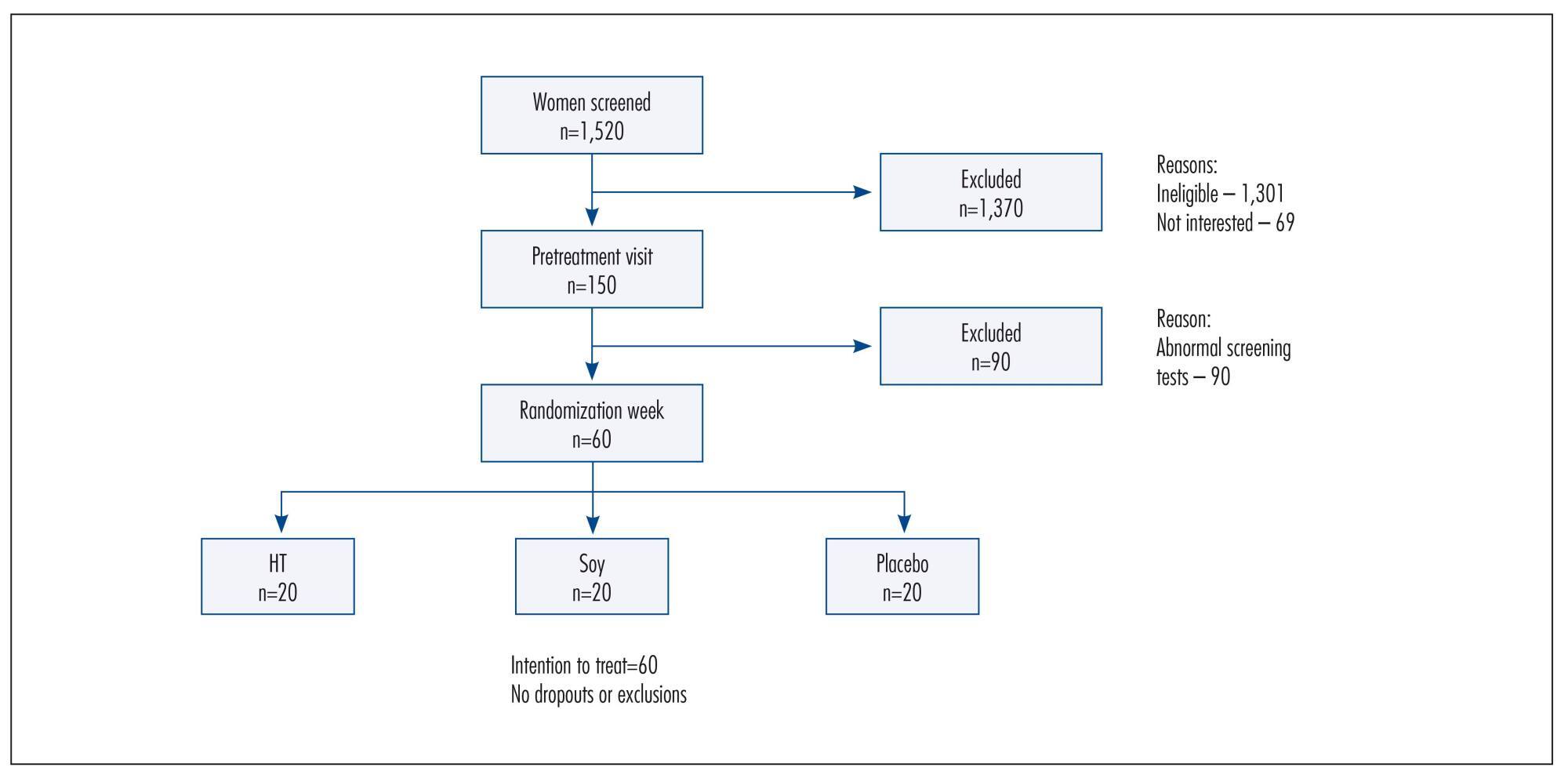
Summary
Revista Brasileira de Ginecologia e Obstetrícia. 2006;28(4):251-263
DOI 10.1590/S0100-72032006000400008
The human chorionic gonadotropin (hCG) results from a non-covalent linkage of two subunits, alpha (alphahCG) and beta (betahCG), separately synthesized by normal trophoblastic tissue, hydatiform mole, choriocarcinoma, pituitary cells, and tumoral tissues of different histologic types. The peptide chain and its further glycosylation in the secretory cell involves the complex action of different enzymes. This complexity results in the secretion of heterogeneous molecular forms. The different molecules might be found in serum, urine and amniotic fluid of pregnant women; serum, urine, and vesicles of patients with hydatiform mole or choriocarcinoma and in other biological fluids of normal non-pregnant women and men or patients with different embryonary types of cancer. Both the intact hCG molecule and its free subunits and the hyperglycosylated (H-hCG), nicked (N-hCG) and core fragment of betahCG (CF- betahCG) variant forms have relevant clinical use. Depending on the prevalent molecular form or the proportion of the variant form to the intact hCG in a determined clinical situation the measurement of a specific molecule is chosen. This review analyzes the clinical use of hCG and its related molecules in the early detection of ectopic pregnancy or patients with higher risk of abortion, in the identification of an embryo or fetus with chromosomal abnormalities, and in the evaluation of risk for preeclampsia or fetal growth restriction. The review also examines the use of hCG and variant forms as tumor markers. It is concluded that it is useful to measure hCG and/or related molecules in clinical practice, but difficulties in developing and achievement of more sensitive and specific new assays limit their use.
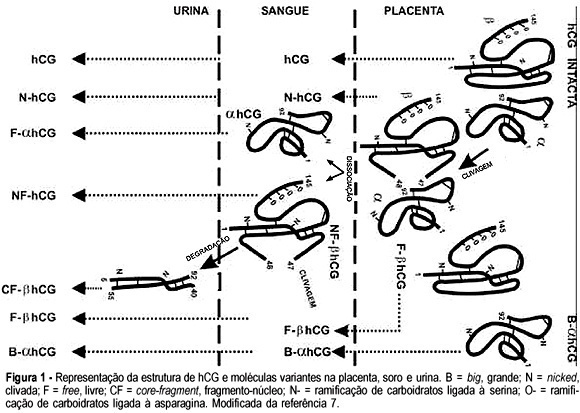
Summary
Revista Brasileira de Ginecologia e Obstetrícia. 1999;21(5):251-258
DOI 10.1590/S0100-72031999000500002
Purpose: to evaluate whether prophylactic use of ampicillin could avoid or reduce maternal and perinatal infectious morbidity caused by premature rupture of membranes (PROM), and to extend the gestation period in those women. Methods: this was a prospective, randomized and double-blind study, carried out evaluating 121 pregnant women with PROM, randomized into two study groups. The treatment group (61 patients) received ampicillin and the control group (60 patients) received placebo. The placebo had the same characteristics as ampicillin (kind of packaging and color of the capsules) and was used in the same time regimen. The considered parameters for maternal infection were febrile morbidity (fever index), and the presence of chorioamnionitis and/or endometritis. The studied neonatal parameters were Apgar score (1st and 5th minutes), bacterial colonization of auditory canal, and blood culture. The statistical tests performed were Fisher's exact test, Wilcoxon, and chi². Results: it was observed that ampicillin did not prolong the gestation, nor did it reduce the postpartum febrile morbidity or the rates of chorioamnionitis and/or endometritis. Ampicillin did not reduce the perinatal infectious morbidity nor improve the birth outcomes. All these results were consistent in cases of less than 72 h PROM. The limited number of cases with time of PROM greater than 72 h did not permit statistical analysis free of type II error. Conclusions: based on these results it was possible to conclude that the prophylactic use of ampicillin by pregnant women with less than 72 h PROM did not reduce either infectious maternal or perinatal morbidity. However, the presence of group B Streptococcus agalactiae in the blood culture from a neonate in the control group showed the necessity to start antibiotic treatment of pregnant women colonized by this microorganism.
Summary
Revista Brasileira de Ginecologia e Obstetrícia. 2018;40(5):251-259
The aim of this work was to evaluate the changes caused by estrogen deficiency in lipid metabolism.
This study encompassed direct measurements of plasma biochemical analyses, liver lipid contents, and assessments of the mitochondrial β-oxidation capacity as well as an evaluation of the liver redox status in an animal model of estrogen deficiency.
When compared with control mice, the livers of ovariectomized (OVX) mice presented considerable accretions in their lipid contents, which were accompanied by increased levels of lipid peroxidation in liver homogenates andmitochondria from OVX groups and decreased reduced glutathione (GSH) contents. In isolated mitochondria, estrogen deficiency inhibited mitochondrial β-oxidation of fatty acids irrespective of their chain length. The liver mitochondrial and peroxisomal H2O2 generations in OVX mice were increased. Additionally, the activities of all antioxidant enzymes assessed were decreased.
These data provide one potential explanation for the increased susceptibility to metabolic diseases observed after menopause.
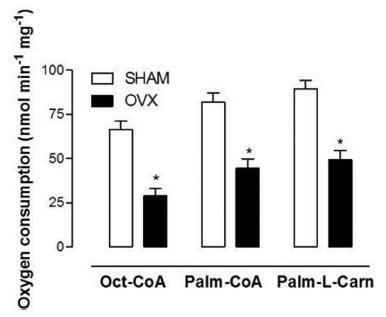
Summary
Revista Brasileira de Ginecologia e Obstetrícia. 2022;44(3):251-257
To evaluate the reproductive and histological characteristics of fresh cultured ovarian tissue from transgender male patients.
An in vitro pilot study in which samples were collected during sex reassignment surgery for transgender male patients. The ovarian cortex was cut into fragments of 2 mm, 3mm, and 4 mm, and placed in a 96-well plate suitable for cultivation at days 0, 2, 4, 6, and 8, when the histology was analyzed.
Stromal hyperplasia was observed in all samples, and it was not associated with the obtainment of primordial or primary follicles. Peripheral reduction in cell count was also a recurrent finding. Primordial and primary follicles were identified with a heterogeneous pattern in fragments from the same patient and from different patients, and follicles in more advanced stages of development (secondary and antral) were not found. There was an association between the diameter of the ovarian fragments and the identification of primary follicles (p=0.036). The number of days in culture was associated with histological signs of tissue damaging in the fragments (p=0.002). The total number of follicles identified in the samples with 2mm in diameter was significantly lower than in those that measured 4mm in diameter (p=0.031).
A diameter of 4mm is suitable for ovarian tissue culture with the benefit of ease of handling. Even after prolonged exposure to testosterone, the ovarian fragments presented primordial and primary follicles, maintaining viability throughout the days they were exposed to the culture. Freezing the ovarian cortex of transgender patients who will undergo surgery for gender reassignment would be an interesting option, in the future, for the preservation of fertility.
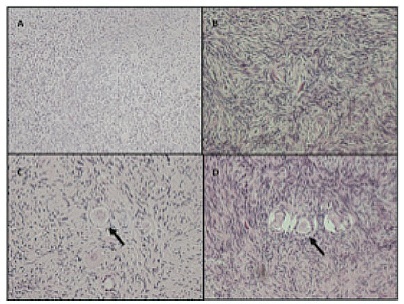
Summary
Revista Brasileira de Ginecologia e Obstetrícia. 2015;37(6):252-257
DOI 10.1590/SO100-720320150005278
To determine the feasibility of evaluation of the right subclavian artery during
the first trimester ultrasound scan, as well as to describe the technique for its
evaluation and, in case of aberrant right subclavian artery (ARSA) identification,
to determine its association with chromosomal abnormalities and/or cardiac
malformations and its management.
A prospective study for evaluation of the right subclavian artery during the
first trimester ultrasound scan (crown-to-rump length between 45 and 84 mm), in
all consecutive single pregnancies, by a single examiner, using a Voluson E8
system (GE Healthcare, Zipf, Austria) with a 2 to 8 MHz RAB 4-8-D transabdominal
probe, within a short period of time (less than 2 minutes), in a general low risk
population. Color and/or power Doppler flow mapping was used to classify the right
subclavian artery as normal or aberrant. Regression analysis with the IBM SPSS
Statistics software for Windows, version 20.0 was used to determine the
significance of the association between failure to examine/classify the right
subclavian artery and both fetal crown-rump length and maternal body mass index.
Median maternal age was 30 years (range: 17-43 years) and median gestational age
at the time of evaluation of the right subclavian artery was 12 weeks (range:
11-13 weeks). The evaluation of the right subclavian artery was successful in
138/176 (78.4%) of the cases. ARSA was diagnosed in a single case (0.7%). This
fetus with ARSA also presented a hyperechogenic focus on the left cardiac
ventricle. Fetal echocardiography at 16 weeks of gestation was performed and
confirmed ARSA and the hyperechogenic focus. Amniocentesis revealed a normal 46,
XX karyotype.
ARSA can be identified during a routine first trimester ultrasound scan. Our
single ARSA case had a normal karyotype and no associated cardiac
malformations.
